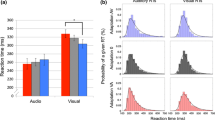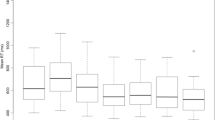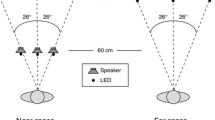Abstract
The brain integrates information from multiple sensory modalities and, through this process, generates a coherent and apparently seamless percept of the external world. Although multisensory integration typically binds information that is derived from the same event, when multisensory cues are somewhat discordant they can result in illusory percepts such as the “ventriloquism effect.” These biases in stimulus localization are generally accompanied by the perceptual unification of the two stimuli. In the current study, we sought to further elucidate the relationship between localization biases, perceptual unification and measures of a participant’s uncertainty in target localization (i.e., variability). Participants performed an auditory localization task in which they were also asked to report on whether they perceived the auditory and visual stimuli to be perceptually unified. The auditory and visual stimuli were delivered at a variety of spatial (0°, 5°, 10°, 15°) and temporal (200, 500, 800 ms) disparities. Localization bias and reports of perceptual unity occurred even with substantial spatial (i.e., 15°) and temporal (i.e., 800 ms) disparities. Trial-by-trial comparison of these measures revealed a striking correlation: regardless of their disparity, whenever the auditory and visual stimuli were perceived as unified, they were localized at or very near the light. In contrast, when the stimuli were perceived as not unified, auditory localization was often biased away from the visual stimulus. Furthermore, localization variability was significantly less when the stimuli were perceived as unified. Intriguingly, on non-unity trials such variability increased with decreasing disparity. Together, these results suggest strong and potentially mechanistic links between the multiple facets of multisensory integration that contribute to our perceptual Gestalt.





Similar content being viewed by others
References
Bermant RI, Welch RB (1976) Effect of degree of separation of visual-auditory stimulus and eye position upon spatial interaction of vision and audition. Percept Mot Skills 42:487–493
Bertelson P, Aschersleben G (1998) Automatic visual bias of perceived auditory location. Psychon Bull Rev 5:482–489
Bertelson P, Radeau M (1981) Cross-modal bias and perceptual fusion with auditory-visual spatial discordance. Percept Psychophys 29:578–584
Choe CS, Welch RB, Gilford RM, Juola JF (1975) The “ventriloquist effect”: visual dominance or response bias? Percept Psychophys 18:55–60
Hairston WD, Wallace MT, Vaughan JW, Stein BE, Norris JL, Schirillo JA (2003) Visual localization ability influences cross-modal bias. J Cogn Neurosci 15:20–29
Hartigan PM (1985) Statistical algorithms: algorithm AS 217. Computation of the dip statistic to test for unimodality. Appl Stat 34:320–325
Hartigan JA, Hartigan PM (1985) The dip test of unimodality. Ann Stat 13:70–84
Howard IP, Templeton WB (1966) Human Spatial orientation. Wiley, New York
Jack CE, Thurlow WR (1973) Effects of degree of visual association and angle of displacement on the “ventriloquism” effect. Percept Mot Skills 37:967–979
Lewald J, Guski R (2003) Cross-modal perceptual integration of spatially and temporally disparate auditory and visual stimuli. Cogn Brain Res 16:468–478
Lewald J, Ehrenstein WH, Guski R (2001) Spatio-temporal constraints for auditory—visual integration. Behav Brain Res 121:69–79
Pick HL, Warren DH, Hay JC (1969) Sensory conflict in judgements of spatial direction. Percept Psychophys 6:203–205
Radeau M, Bertelson P (1987) Auditory-visual interaction and the timing of inputs: Thomas (1941) revisited. Psychol Res 49:17–22
Slutsky DA, Recanzone GH (2001) Temporal and spatial dependency of the ventriloquism effect. Neuroreport 12:7–10
Stein BE, Meredith MA (1993) The merging of the senses. MIT Press, Cambridge MA
Stein BE, Wallace MT (1996) Comparisons of cross-modality integration in midbrain and cortex. Prog Brain Res 112:289–299
Stein BE, Laurienti PJ, Wallace MT, Stanford TR (2002) Multisensory integration. In: Ramachandran V (ed) Encyclopedia of the human brain. Elsevier, Amsterdam, pp 227–241
Thomas G (1941) Experimental study of the influence of vision on sound localisation. J Exp Psychol 28:167–177
Thurlow WR, Jack CE (1973) Certain determinants of the “ventriloquism effect”. Percept Mot Skills 36:1171–1184
Wallace MT, Stein BE (1996) Sensory organization of the superior colliculus in cat and monkey. Prog Brain Res 112:301–311
Wallace MT, Meredith MA, Stein BE (1992) Integration of multiple sensory modalities in cat cortex. Exp Brain Res 91:484–488
Wallace MT, Wilkinson LK, Stein BE (1996) Representation and integration of multiple sensory inputs in primate superior colliculus. J Neurophysiol 76:1246–1266
Wallace MT, Meredith MA, Stein BE (1998) Multisensory integration in the superior colliculus of the alert cat. J Neurophysiol 80:1006–1010
Warren DH, Welch RB, McCarthy TJ (1981) The role of visual-auditory compellingness in the ventriloquism effect: implications for transitivity among the spatial senses. Percept Psychophys 30:557–564
Welch RB, Warren DH (1980) Immediate perceptual response to intersensory discrepancy. Psychol Bull 88:638–667
Acknowledgements
We thank Julie Edelson for editorial assistance. The study was supported in part by US National Institutes of Health grants MH63861, NS22543 and NS36916.
Author information
Authors and Affiliations
Corresponding author
Rights and permissions
About this article
Cite this article
Wallace, M.T., Roberson, G.E., Hairston, W.D. et al. Unifying multisensory signals across time and space. Exp Brain Res 158, 252–258 (2004). https://doi.org/10.1007/s00221-004-1899-9
Received:
Accepted:
Published:
Issue Date:
DOI: https://doi.org/10.1007/s00221-004-1899-9




